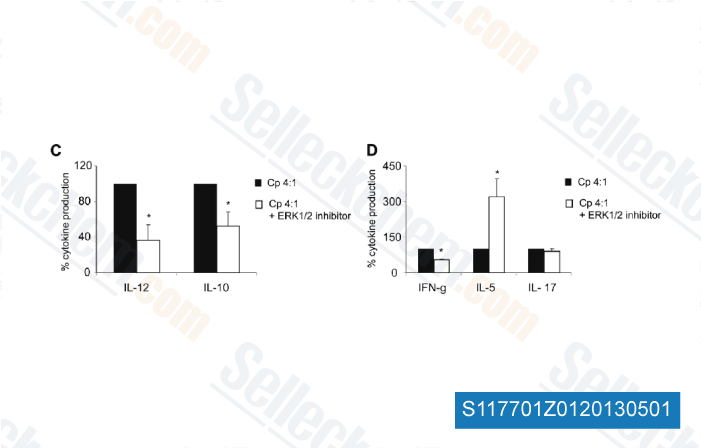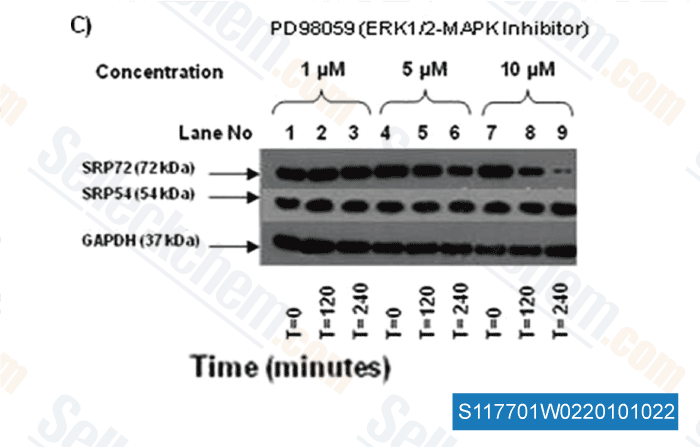|
Toll Free: (877) 796-6397 -- USA and Canada only -- |
Fax: +1-832-582-8590 Orders: +1-832-582-8158 |
Tech Support: +1-832-582-8158 Ext:3 Please provide your Order Number in the email. |
Technical Data
| Formula | C16H13NO3 |
||||||||||
| Molecular Weight | 267.28 | CAS No. | 167869-21-8 | ||||||||
| Solubility (25°C)* | In vitro | DMSO | 46 mg/mL (172.1 mM) | ||||||||
| Water | Insoluble | ||||||||||
| Ethanol | Insoluble | ||||||||||
| In vivo (Add solvents to the product individually and in order) |
|
||||||||||
|
* <1 mg/ml means slightly soluble or insoluble. * Please note that Selleck tests the solubility of all compounds in-house, and the actual solubility may differ slightly from published values. This is normal and is due to slight batch-to-batch variations. * Room temperature shipping (Stability testing shows this product can be shipped without any cooling measures.) |
|||||||||||
Preparing Stock Solutions
Biological Activity
| Description | PD98059 is a non-ATP competitive MEK inhibitor with IC50 of 2 μM in a cell-free assay, specifically inhibits MEK-1-mediated activation of MAPK; does not directly inhibit ERK1 or ERK2. This compound is a ligand for the aryl hydrocarbon receptor (AHR) and functions as an AHR antagonist. | ||||
|---|---|---|---|---|---|
| Targets |
|
||||
| In vitro | PD98059 inhibits either basal MEK1 or a partially activated MEK produced by mutation of serine at residues 218 and 222 to glutamate (MEK-2E) with IC50 of 2 μM. This compound does not inhibit the MAPK homologues JNK and P38. It is highly selective against MEK, as it does not inhibit a number of other kinase activities including Raf kinase, cAMP-dependent kinase, protein kinase C, v-Src, epidermal growth factor (EGF) receptor kinase, insulin receptor kinase, PDGF receptor kinase, and phosphatidylinositol 3-kinase. This inhibitor inhibits PDGF-stimulated activation of MAPK and thymidine incorporation into 3T3 cells with IC50 of ~10 μM and ~7 μM, respectively. [1] It potently prevents the activation of MEK1 by Raf or MEK kinase with IC50 of 4 μM, and weakly inhibits the activation of MEK2 by Raf with IC50 of 50 μM. This chemical does not inhibit the activation of MEK homologues MKK4 and RK kinase that participate in stress and interleukin-1-stimulated kinase cascades in KB and PC12 cells, and the activation of p70 S6 kinase by insulin or epidermal growth factor in Swiss 3T3 cells. [2] It completely blocks the nerve growth factor (NGF)-induced differentiation of PC12 cells without altering cell viability. [3] This compound inhibits the proliferation of RAW264.7 cells in the culture containing RANKL in a dose-dependent manner, resulting in an apparent decrease of TRAP-positive cells. [4] |
||||
| In vivo | Treatment of mice 30 minutes before focal cerebral ischemia with PD98059 protects against damage, resulting in a decrease in infarct volume. [5] Pretreated with this compound 30 minutes before and then together with hourly cerulein injections for 3 hours significantly ameliorates cerulein-induced acute pancreatitis ipancreatitis on the basis of pancreatic wet weight and histology. [6] Administration of this chemical (10 mg/kg) in mice 1 hour after carrageenan causes a reduction in all the parameters of inflammation measured. [7] |
||||
| Features | Does not inhibit c-Raf phosphorylated MEK1. |
Protocol (from reference)
| Kinase Assay: |
|
|---|---|
| Cell Assay: |
|
| Animal Study: |
|
References
|
Customer Product Validation

-
Data from [ Microbes Infect , 2013 , 15, 105-14 ]

-
Data from [ J Natl Cancer Inst , 2012 , 104(21), 1673-9 ]

-
Data from [ J Natl Cancer Inst , 2012 , 104(21), 1673-9 ]

-
Data from [ J Biol Chem , 2010 , 285, 32824-32833 ]
Selleck's PD98059 Has Been Cited by 541 Publications
| Mitochondrial-cytochrome c oxidase II promotes glutaminolysis to sustain tumor cell survival upon glucose deprivation [ Nat Commun, 2025, 16(1):212] | PubMed: 39747079 |
| Calnexin promotes glioblastoma progression by inducing protective mitophagy through the MEK/ERK/BNIP3 pathway [ Theranostics, 2025, 15(6):2624-2648] | PubMed: 39990231 |
| Role of the androgen receptor in melanoma aggressiveness [ Cell Death Dis, 2025, 16(1):34] | PubMed: 39837817 |
| HEP14-activated PKC-ERK1/2 pathway boosts HEP14-empowered hADSCs for ovarian regeneration and functional restoration [ Commun Biol, 2025, 8(1):1267] | PubMed: 40849553 |
| BMSC exosomes deliver JKAP to restore Th17/Treg balance via AKT/ERK, alleviating rheumatoid arthritis [ iScience, 2025, 28(7):112832] | PubMed: 40687841 |
| Ursolic Acid Inhibits Collagen Production and Promotes Collagen Degradation in Skin Dermal Fibroblasts: Potential Antifibrotic Effects [ Biomolecules, 2025, 15(3)365] | PubMed: 40149901 |
| FAM49B suppresses ovarian cancer cell growth through regulating MAPK signaling [ Am J Cancer Res, 2025, 15(9):4150-4164] | PubMed: 41113986 |
| Oncogenic Activity and Sorafenib Sensitivity of ARAF p.S214C Mutation in Lung Cancer [ Cancers (Basel), 2025, 17(13)2246] | PubMed: 40647542 |
| Deficiency of fibroblast growth factor 2 promotes contractile phenotype of pericytes in ascending thoracic aortic aneurysm [ Am J Physiol Heart Circ Physiol, 2025, 328(5):H1130-H1143] | PubMed: 40214073 |
| Intracellular Sphingosine-1-Phosphate Induces Lipolysis Through Direct Activation of Protein Kinase C Zeta [ FASEB J, 2025, 39(7):e70528] | PubMed: 40193069 |
RETURN POLICY
Selleck Chemical’s Unconditional Return Policy ensures a smooth online shopping experience for our customers. If you are in any way unsatisfied with your purchase, you may return any item(s) within 7 days of receiving it. In the event of product quality issues, either protocol related or product related problems, you may return any item(s) within 365 days from the original purchase date. Please follow the instructions below when returning products.
SHIPPING AND STORAGE
Selleck products are transported at room temperature. If you receive the product at room temperature, please rest assured, the Selleck Quality Inspection Department has conducted experiments to verify that the normal temperature placement of one month will not affect the biological activity of powder products. After collecting, please store the product according to the requirements described in the datasheet. Most Selleck products are stable under the recommended conditions.
NOT FOR HUMAN, VETERINARY DIAGNOSTIC OR THERAPEUTIC USE.
